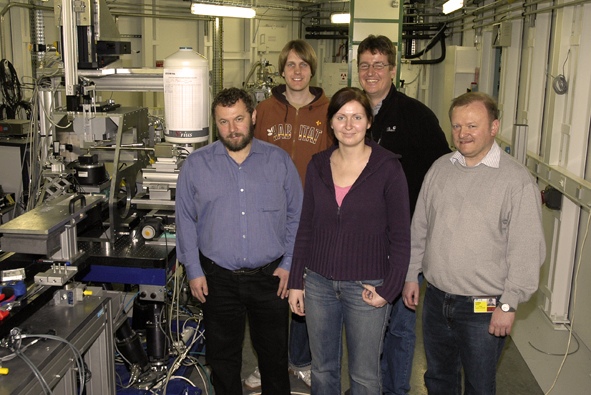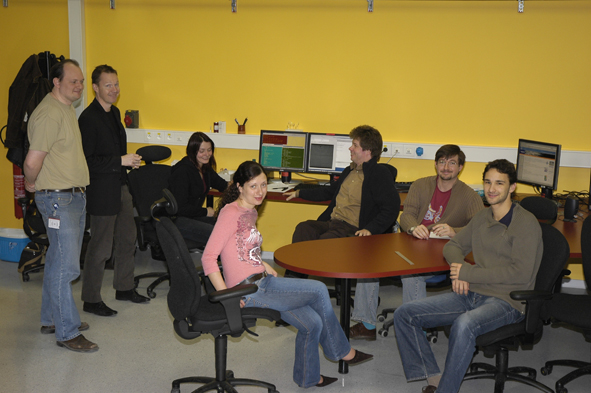- Home
- News
- General News
- Long beamlines for...
Long beamlines for nano beams
13-03-2007
Two experimental stations of the ESRF have been extended with the aim of carrying out research at the nanoscale. Their first users arrived in the beginning of March and were already nicely surprised with good news.
Share
When the users receive you with a smile on their face after several days of experiment, you can guess that they are going back home with lots of useful data. If you add to this the fact that these are the first users on the beamline, their smile is worth double. Since this week, the two ESRF extended beamlines are up and running, and users seem happy.
 |
|
The first team of users on the extended ID13 with their local contact. |
Thanks to dedication of the technical and scientific staff, the extensions of the materials science beamline ID11, led by Gavin Vaughan and the microfocus beamline ID13, led by Christian Riekel have already had the first users. After 6 months of construction, the two beamlines have doubled their length. The sample is now located at about 100 metres from the source and the beam size has reduced drastically.
The first team of the extended ID11 is a group from the École Polytechnique Fédérale de Lausanne (Switzerland), led by Marc Schiltz. As a part of a long term project with the ESRF, they were focusing on the analysis of proteins with many crystals. “It is often very difficult to grow a large single crystal for X-ray analysis, so our approach is to find a method to analyse many thousands of submicron crystals”, explains Schiltz.
The team has already carried out experiments on ID31, which Schiltz defines as complementary to ID11. The first one a very high instrumental resolution, whilst the new ID11 uses an area detector, provides a stronger intensity and still has a good angular resolution, because the detector can be set far from the sample.
Some metres further in the ring, on the extended ID13 the users were getting the beam as small as it could get. “We develop refractive X-ray lenses and a set up to diminish the beam size”, explains Christian Schroer, leader of the team from the Technische Universität Dresden (Germany). The aim is to eventually integrate the lenses on the beamlines permanently, as a part of a long term project with the ESRF ID13 beamline. “For the moment we have reached 80 nanometres size, which is not bad at all”, asserts Schroer.
|
|
|
The users of the new ID11 with some of the beamline staff. |
Apart from their quest for nanobeams, the Dresden team also carried out fluorescence imaging experiments on a meteorite sample together with the group of Frank Brenker (Frankfurt University, Germany) and samples of the model plant Arabidopsis thaliana in collaboration with Walter Schröder (Research Center Jülich, Germany). Of both samples they made element maps of micrometre-sized regions, searching for small pieces of pre-solar material in the first and heavy metal accumulations in the latter. “This plant accumulates heavy metals in a very heterogeneous way, so we do need a very small and stable beam, such as the one on ID13”, explains Schroer.
These are early days for both ID11 and ID13, and the feedback of the first teams is crucial. The smiles on their faces prove their satisfaction with their experiments. Marc Schild asserts: “the data looks very promising”.
More information about ID11 and ID13 extensions can be found here:
www.esrf.fr/UsersAndScience/Experiments/SoftMatter/ID13/nanofocus




